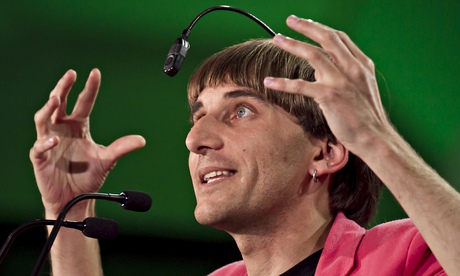
Wherever humans live or have lived, you will find art. It looms up on remote Pacific islands and on rocks in the Sahara. For students of human evolution it is what marks the coming of the "modern human mind": the superb cave art of the last ice age reveals the arrival of homo sapiens – and our modern brains – in Europe.
But is seeing art as unmistakably human a complacent bit of self-regard? Claims are constantly made that aesthetic impulses existed in our ancestors long before they were "modern humans". The symmetrical handaxes hewn more than a million years ago in places such as Olduvai Gorge in Tanzania, for example, blur the creative border between artists and animals.
The most immediate challenge to the belief that art is essentially human comes from the dawning future rather than the remote past. In the computer age, lines between the human brain and body and the machines that surround us are becoming ever less certain. For some, this is the beginning of the cyborg age, when our weaknesses will be made good by machinery and people will be part human, part robot, part computer.
Far from being merely a plot theme in Doctor Who, cyborgs already walk among us. What does this mean for art?
On 27 August, the cyborg artists Neil Harbisson and Moon Ribas will perform at Hyphen-Hub Salon in New York City, exploring how new electronic senses and technologically transformed bodies may alter art.
Harbisson, who claims to be the world's first officially recognised cyborg, has an implant in his brain that lets him "hear" colours vibrating in his skull – thus prosthetically compensating for the fact that he is colour-blind. For his "skull transmission" performance this week, passers-by in Times Square will be invited to paint colours that will be transmitted as sound waves to Harbisson's brain – and he will try to copy the painting live.
Moon Ribas, who has an implant in her elbow that allows her to feel earthquakes as seismic data transmitted directly to her body, will dance to the vibrations of whatever quakes are occurring anywhere on the planet at the time of her performance.
Will such evenings one day be remembered as the first stirrings of a revolutionary new sensibility?
Harbisson and Ribas challenge the very idea that humans have one innate set of abilities with which to make and perceive art. A colour-blind painter who perceives colour as electronically created vibrations in his brain is not reliant on a given biological package – the implication is that soon we may all be able to customise our senses, to smell sound, or feel colour as a tingling on our skins, say. What will that mean for art?
Is the day just round the corner when art lovers will sit in darkened rooms feeling art vibrate inside their skulls? Will such experiments introduce a totally new sensuality, as we explore remote regions of emotion and poetry made possible by technology?
We don't really know what art is, or why it matters so much to our strange species. Since we don't know what it is, we can't say it is bound to a particular set of senses and skills that happen to be unique to one clever ape. As our ape nature is transformed and we evolve into cyborgs, a new universe of beauty may be just around the corner.

